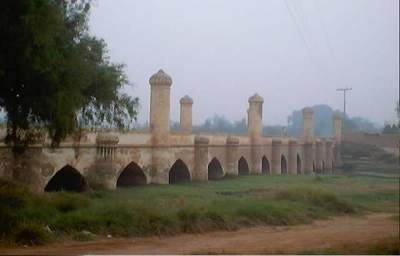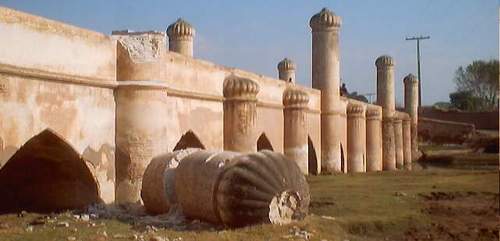| Copyright � 2004 [Sarhad Conservation Network]� All rights reserved. |
 |
| Romancing the Glorious Mughal Bridge in Peshawar by Adil Zareef |
| This magnificent bridge over the renowned Bara River presents a beautiful illustration of Mughal era architecture. Built around 17th century, it is composed of Waziri tiles, fortified with lime, mud and jute mixture. Connecting Pul Choha, Urmur and Phandu Payan it is also known as Choha Gujar bridge, the locals call it Spin (white) Pul owing to its light shade. One of the three other similar Mughal bridges on the Grand Trunk Road in Pakistan, this is only one of its kind in the entire province and still open to traffic. Its history can be traced to Emperor Shah Jehan�s reign. Some believe that it may even have been built earlier during Sher Shah Suri�s period, as it crossed the original GT road built by him, and may have been restored by the Mughals later. The local residents also credit the renowned philanthropist, Haji Karim Buksh Sethi with its construction, although he lived during 1861-1930. Since the style is distinctively Mughal, this sounds as a conjecture. More likely, he had refurbished the bridge during his lifetime. But interestingly, the bridge is still popularly called the �Sethian Bridge�. Archeologists and historians are well advised to shed light on the origins of this unique bridge. Despite the ravages of time, this amazing structure still withstands, even today, a stream of heavy traffic and all kinds of communication. Even tractor-trolleys and over loaded trucks! It has twelve tunnels, for the river Bara, constructed with Waziri tiles and graceful mehrabs (arches) below. The bridge stands 290 feet and 15 inches in length, and is 33 feet and 2.5 inches wide. The breath taking Mughal Bridge on the old G T Road stands on 26 small and large pillars. Of these, 5 large pillars extend 12 feet over the bridge in the shape of minarets. This not only enhances the structural strength but also its beauty. The pillars have a width of 7 feet and 16 inches and exhibit a variety of lovely murals and ornate designs. The upper part of the bridge still exhibits a linear shaped beautiful pattern of the bygone period. An awesome, towering 2000-year old Banyan (Barr) tree stands a few yards away from this historic bridge on the eastern side towards Chamkani. The foliage is so extensive, it can easily be seen from far away. Nearby, there is another bunch of 15 similar (smaller) trees. The big Banyan is 200 feet high and 130 feet wide and its roots cover over half a kilometer. Sadly the Banyan tree is also threatened by mindless development. The construction of a high school and a mosque has chopped off its parts, and if conservation strategies are not employed we may lose this unique sample of biodiversity. |
 |
| Having withstood the turmoil of last 300 years, the Mughal Bridge has fallen victim to official mal-administration and ill planning. The constant (particularly) heavy traffic has weakened its structure and two of its great pillars have already fallen prey to this criminal neglect. One of the pillars fell recently, on 25th December 2003 at nighttime. The protective wall on the eastern front has also vanished. Two decorative minarets are also on the verge of collapse and repeated repair of the road has also harmed its architectural beauty and life. These and other structures can easily be restored if timely action is taken now. The authorities concerned are earnestly requested that the heavy traffic should immediately be stopped and urgent attention of UNESCO, the media, and archeological and cultural heritage government departments be drawn towards the restoration of this only one of its kind Mughal Bridge - a rare piece of cultural and historical heritage - on the verge of becoming extinct because of our shameful negligence - a mere memory of our past grandeur. (Sarhad Conservation Network) |
